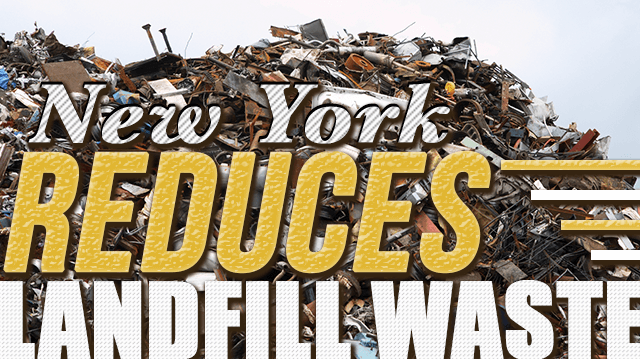
We all do it: When dinner’s over someone invariably has left scraps on their plate. Most of us simply scrape those scraps into the trash can. Multiply that by 115,000,000-plus households across the U.S. and factor in all of the restaurants that do the same thing, and we’re talking about tons of food waste. Earlier this month, New York Governor Andrew Cuomo announced that his state is going to do something about that, with an anaerobic digester that will accept 180,000 tons of food waste per year.
In the U.S., 30 to 40 percent of our food supply is wasted; that equals about 20 pounds of food per person, per month, according to the United Nations Environment Programme (UNEP). While this wasting of food is troublesome for world hunger reasons, it also means that our landfills are chock-full of organic waste. Food waste is the second most common item in our landfills, and a huge contributor to methane gas levels.
In August 2016, American Organic Energy will flip the switch “on” at a new anaerobic digester in Yaphank, where Long Island Compost currently operates. American Organic Energy will partner with GE Water, Quasar Energy and Scott’s Miracle-Gro to “collect, separate, pre-process, break down, and transform Long Island’s food waste into convertible energy, vehicle fuel, electricity, fertilizer, and nutrient-rich water,” according to the company’s website.
Here’s how it works
One hundred eighty thousand tons of food waste, 30,000 tons of oil and grease, and 10,000 tons of grass clippings will be collected at the facility. All non-organic material, including plastic, paper and metal items, will be separated from the organic. Then it will be placed in oxygen-free tanks for a month while microorganisms go to work breaking down the biodegradable material.
During anaerobic digestion — the process of breaking materials down in an oxygen-free environment — two substances are produced. One of these is digestate, a solid organic material. This will go to companies that make topsoil and will return to the environment as clean, organic fertilizer. The other substance produced is biogas. This gas will be used to power the trucks that transport food waste to the facility, and will be used to power the facility itself. The sustainable cycle starts again when the biogas-powered trucks are sent out from the facility to collect more organic material.
Long-term benefits
 The digester, which is part of New York’s Cleaner, Greener Communities program, is set to “reduce greenhouse gas emissions by approximately 40,000 tons annually, equivalent to removing 8,125 cars from the road.” The biogas produced at the facility will also enable Long Island Compost to reduce its diesel gasoline consumption by 200,000 gallons per year, with an additional 1.9 million gallons “offset by injecting the remaining renewable gas produced by the digester into the National Grid natural gas pipeline on Long Island,” so that the gas may be used for other vehicles that run on natural gas.
The digester, which is part of New York’s Cleaner, Greener Communities program, is set to “reduce greenhouse gas emissions by approximately 40,000 tons annually, equivalent to removing 8,125 cars from the road.” The biogas produced at the facility will also enable Long Island Compost to reduce its diesel gasoline consumption by 200,000 gallons per year, with an additional 1.9 million gallons “offset by injecting the remaining renewable gas produced by the digester into the National Grid natural gas pipeline on Long Island,” so that the gas may be used for other vehicles that run on natural gas.
The innovative project is the first large-scale anaerobic digester in the area. We can only hope that it provides a great example to both the New York Metropolitan Area and the rest of the country, that diverting food waste from landfills is not only doable, but greatly benefits current and future generations.
-Megan Winkler
Megan Winkler is an author, historian, Neurosculpting® meditation coach, certified nutritional consultant and DIY diva. When she’s not writing or teaching a class, Megan can be found in the water, on a yoga mat, learning a new instrument or singing karaoke. Her passion for a healthy mind-body-spirit relationship motivates her to explore all the natural world has to offer.
Sources:
http://quickfacts.census.gov/qfd/states/00000.html
http://www.worldfooddayusa.org/food_waste_the_facts
http://www.usbiopower.com/organic-energy/anaerobic-digester/
http://www.governor.ny.gov/news/governor-cuomo-announces-innovative-clean-energy-project-long-island-under-reforming-energy

